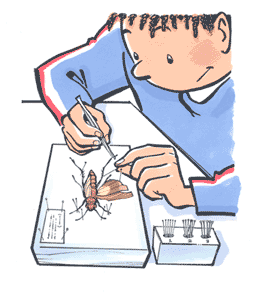Building an insect collection involves following a specific protocol, methods and materials for collecting insects and related data, displaying specimens, determining species and canning. This article, the precedents and the following are therefore intended to present how I proceed.
How to determine an insect species
Once an insect has been captured (see th article), prepared (see this article) and installed in the collection (see th article), it is a question of finding its name. This part is tedious, requires using a binocular magnifying glass and knowledge in insect morphology. The identification criteria are for the most part discreet, subtle and difficult to observe, such as the presence or not of silks on a particular article, such as the ratio between the width and length of a particular part of the body or the texture of the cuticle.
To identify an insect, there are what are called “identification keys” or “determination keys”. These keys work on a dichotomous system, i.e. it is based on a double description succession of one or more specific morphological characters. The next step is taken by answering “yes” or “no” (see example). Thus, from character to character, one advances in the key (Family, Sub-Family, Gender) until arriving at a species. There are keys for all Living Constituent Orders.
caption id=”attachment_954″ align=”aligncenter” width=”300″] Start of a determination key for the family Carabidae (Coleoptera)[/caption]
Start of a determination key for the family Carabidae (Coleoptera)[/caption]
The identification of an insect is thus in a way an investigation, in the sense that from morphological indices, one arrives at a species.
To determine my insects, over the years, I have compiled a bibliography covering most families (Cerambycidae, Syrphidae, Carabidae, etc.). I have obtained these keys through the purchase of specialized books, through websites that offer online and open access digital keys and through forums. I have indeed, through these forums, integrated a community of enthusiasts (amateurs and professionals) who advise, help and exchange information and documents.
For example, the forum”The world of Insects” is a great tool from novices to the most experienced. The objective is to offer enthusiasts a place to share and exchange information, where everyone brings their experiences and knowledge. All subjects can be treated and developed. There are links to other sites, determination keys, internships, various tips… Determinations can also be submitted to members, using photo(s), for discussion and help in validating them. These exchanges between members are fun and educational.
In addition, this site provides a photographic database of species determined by forum members. The galerie, composed of thousands of photos classified by Family, Genus and species allows everyone to compare and verify their identification. Day by day, the gallery is enriched with new photos and species (see photo). Congratulations to the administrators of this site!
caption id=”attachment_947″ align=”aligncenter” width=”300″] Example of a gallery page, here, flies of the Syrphidae Family[/caption]
Example of a gallery page, here, flies of the Syrphidae Family[/caption]
Finally, the interest of this work, ants! is to be an important source of information on the distribution of species in France scientifically valued by inventories at the national level, the creation of Atlas and programs to preserve natural areas with high biodiversity. Each member thus becomes an indispensable actor and observer at a time when biodiversity is in danger and the number of entomologists is limited.
I propose you another forum, specialized in Diptera (flies) and in English: “Diptera.info“. Its operation and objective are the same as for”The world of Insects“.
The classification of insects, and life in general, is constantly updated according to new discoveries and new data. When building a collection, the hierarchical position of a species in the classification as well as the number of species present in such genus are recurrent questions. To answer these questions, the website Fauna Europaea is an indispensable tool. The objective of this site is to list and reference all animal species in Europe, their place in the classification (taxonomic), synonyms and the names of experts. For example, see photo below.
caption id=”attachment_951″ align=”aligncenter” width=”300″] Example of classification for Camponotus vagus species (Source : Fauna Europaea)[/caption]
Example of classification for Camponotus vagus species (Source : Fauna Europaea)[/caption]
As you can see, building a collection of insects takes a lot of time, patience and knowledge, but actually, for an enthusiast like me, it’s a hobby that offers only pleasure and satisfaction.
I am, of course, at your disposal for any questions, requests for advice, tips and/or expertise. Do not hesitate to contact me here. Looking forward to reading and helping you!
Recommendations for books on this theme:
– Insects from France and Europe
– Europe’s phytophagous beetles, volume 1
– Plant Pest Control Coleoptera of Europe. Tome 2, Chrysomelidae
– Guide des libellules de France et d’Europe
– Guide photo des papillons d’Europe
– Le guide des sauterelles, grillons et criquets d’Europe occidentale (1CD audio)
– Fourmis de France, de Belgique et du Luxembourg


